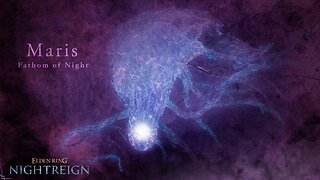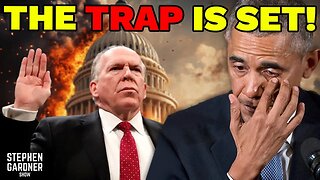Premium Only Content

The History of Bioweapons Experimentation on US Citizens
Cause Before Symptom - With Your Host James Carner
The History of Bioweapons Experimentation on US Citizens
From the Cold War to the War on Terror, successive American administrations have turned a blind eye on dubious research rightly characterized as having “a little of the Buchenwald touch.”
While the phrase may have come from the files of the Atomic Energy Commission as Pulitzer prize-winning journalist Eileen Welsome revealed in her 1999 book, The Plutonium Files, an investigation into secret American medical experiments at the dawn of the nuclear age, it is as relevant today as the United States pours billions of dollars into work on some of the most dangerous pathogens known to exist in nature.
That Cold War securocrats were more than a little concerned with a comparison to unethical Nazi experiments is hardly surprising. After all, with the defeat of the Axis powers came the triumphalist myth-making that America had fought a “good war” and had liberated humanity from the scourge of fascist barbarism.
Never mind that many of America’s leading corporations, from General Motors to IBM and from Standard Oil to Chase National Bank, were sympathizers and active collaborators with the Third Reich prior to and even during World War II, as documented by investigative journalists Charles Higham in Trading With The Enemy, and Edwin Black in IBM and the Holocaust. Like much else in American history, these were dirty little secrets best left alone.
Soon enough however, these erstwhile democrats would come to view themselves as mandarins of a new, expanding American Empire for whom everything was permitted. In this context, the recruitment of top German and Japanese scientists who had conducted grisly “medical” experiments whilst waging biological war against China and the Soviet Union would be free of any moralizing or political wavering.
As the Cold War grew hotter and hotter, America’s political leadership viewed “former” Nazis and the architects of Japan’s Imperial project not as war criminals but allies in a new undertaking: the global roll-back of socialism and the destruction of the Soviet Union by any means necessary.
This tradition is alive and well in 21st century America. With the September 11, 2001 terrorist attacks and subsequent anthrax mailings as a pretext for an aggressive militarist posture, the national security state is ramping-up research for the production of genetically-modified organisms for deployment as new, frightening weapons of war.
According to congressional testimony by Dr. Alan M. Pearson, Director of the Biological and Chemical Weapons Control Program at the Washington D.C.-based Center for Arms Control and Non-Proliferation, with very little in the way of effective oversight or accountability, tens of billions of dollars “have been appropriated for bioweapons-related research and development activities.” Pearson reveals that approximately $1.7 billion “has been appropriated for the construction on new high containment facilities for bioweapons-related research.”
By high containment facilities I mean facilities that are designed for work with agents that may cause serious or potentially lethal disease through exposure to aerosols (called Biosafety Level 3 or BSL-3 facilities) and facilities that are designed for work with agents that pose a “high individual risk of life-threatening disease, which may be transmitted via the aerosol route and for which there is no available vaccine or therapy” (called Biosafety Level 4 or BSL-4 facilities).
Prior to 2002, there were three significant BSL-4 facilities in the United States. Today twelve are in operation, under construction, or in the planning stage. When completed, there will be in excess of 150,000 square feet of BSL-4 laboratory space (as much space as three football fields). The number of BSL-3 labs is also clearly growing, but ascertaining the amount of growth is difficult in the absence of accurate baseline information. There are at least 600 such facilities in the US. (Alan M. Pearson, Testimony, “Germs, Viruses, and Secrets: The Silent Proliferation of Bio-Laboratories in the United States,” House Energy and Commerce Committee, Subcommittee on Oversight and Investigations, October 2007)
Chillingly, one consequence of this metastatic growth “is that the very labs designed to protect against bioweapons may become a source for them.” As the 2001 anthrax attacks amply demonstrated, the threat posed by a biological weapons’ incident may be closer to home than any of us care to think. Pearson writes, “Nor should we ignore the possibility that a US biologist may become disgruntled or turn rogue while working in one of these labs.”
According to Edward Hammond, the Director of the now-defunct Sunshine Project, while “biological arms control is currently in … its worst crisis since the signing of the Bioweapons Convention (BWC) in 1972,” the American Bioweapons-Industrial Complex has “embarked on the exploitation of biotechnology for weapons development.” Indeed, Hammond relates that active programs utilizing genetic engineering techniques have “been employed in offensive biowarfare programs in order to make biowarfare agents more effective.”
But increases in state subsidies for such work have generated new risks to the public. A recent Government Accountability Office (GAO) report faulted the Centers for Disease Control and Prevention (CDC) for lax security at three of the nation’s five BSL-4 labs currently in operation that “handle the world’s most dangerous agents and toxins that cause incurable and deadly diseases.” Agents such as Ebola, Marburg and smallpox are routinely studied at these facilities. And yet, as GAO auditors found,
Select agent regulations do not mandate that specific perimeter security controls be present at BSL-4 labs, resulting in a significant difference in perimeter security between the nation’s five labs. According to the regulations, each lab must implement a security plan that is sufficient to safeguard select agents against unauthorized access, theft, loss, or release. However, there are no specific perimeter security controls that must be in place at every BSL-4 lab. While three labs had all or nearly all of the key security controls we assessed, our September 2008 report demonstrated that two labs had a significant lack of these controls. (Government Accountability Office, Biosafety Laboratories: BSL-4 Laboratories Improved Perimeter Security Despite Limited Action by CDC, GAO-09-851, July 2009)
As Global Security Newswire revealed in June, a “recently completed inventory at a major U.S. Army biodefense facility found nearly 10,000 more vials of potentially lethal pathogens than were known to be stored at the site.”
The 9,220 samples–which included the bacterial agents that cause plague, anthrax and tularemia; Venezuelan, Eastern and Western equine encephalitis viruses; Rift valley fever virus; Junin virus; Ebola virus; and botulinum neurotoxins–were found during a four-month inventory at the U.S. Army Medical Research Institute of Infectious Diseases at Fort Detrick, Md., according to Col. Mark Kortepeter, the center’s deputy commander. (Martin Matishak, “Thousands of Uncounted Disease Samples Found at Army Biodefense Lab,” Global Security Newswire, June 18, 2009)
The GSN report states that while “half of the newfound material was destroyed after being recorded,” inventory control officer Sam Edwin told reporters that “the other half was deemed worthy for further scientific use, cataloged, and stored in the center’s containment freezers.”
More pertinently, what happens when the state itself turns “rogue” and under cover of national security and the endless “war on terror” creates the “acute risk” in the form of out-of-control laboratories “designed to protect against bioweapons” that instead, have “become a source for them”?
Bioweapons and National Security: A Chronology
Source Notes: This chronology has drawn from dozens of books, articles and declassified government documents in its preparation. Notable in this regard is Michael Christopher Carroll’s Lab 257: The Disturbing Story of the Government’s Secret Germ Laboratory; Linda Hunt, Secret Agenda; Bob Coen and Eric Nadler, Dead Silence: Fear and Terror on the Anthrax Trail; the National Security Archive’s documentary history of U.S. Biological Warfare programs and The Sunshine Project.
* August 1945: Operation Paperclip, an Office of Strategic Services (OSS) program to import top Nazi scientists into the United States. Linda Hunt relates in her book, Secret Agenda, that Reich Health Leader (Reichsgesundheitsführer) Dr. Kurt Blome, was saved from the gallows due to American intervention. Blome admitted he had worked on Nazi bacteriological warfare projects and had experimented on concentration camp prisoners with bubonic plague and sarin gas at Auschwitz. After his acquittal at the 1947 Nuremberg Doctors’ Trial, Blome was recruited by the U.S. Army Chemical Corps and advised the Pentagon on biological warfare. Walter Paul Emil Schreiber, a Wehrmacht general who assigned doctors to experiment on concentration camp prisoners and disbursed state funds for such experiments was another Paperclip recruit; in 1951, Schreiber went to work for the U.S. Air Force School of Medicine. Hubertus Strughold, the so-called “father of space medicine” discussed–and carried out–experiments on Dachau inmates who were tortured and killed; Strughold worked for the U.S. Air Force. Erich Traub, a rabid Nazi and the former chief of Heinrich Himmler’s Insel Riems, the Nazi state’s secret biological warfare research facility defects to the United States. Traub was brought to the U.S. by Paperclip operatives and worked at the Naval Medical Research Institute and gave “operational advice” to the CIA and the biowarriors at Ft. Detrick.
* September 1945: General Shiro Ishii’s Unit 731, a secret research group that organized Japan’s chemical and biological warfare programs is granted “amnesty” by Supreme Allied Commander in the Pacific, General Douglas MacArthur in exchange for providing America with their voluminous files on biological warfare. All mention of Unit 731 is expunged from the record of The Tokyo War Crimes Tribunal. During the war, Unit 731 conducted grisly experiments, including the vivisection of live prisoners, and carried out germ attacks on Chinese civilians and prisoners of war. According to researcher Sheldon H. Harris in Factories of Death: Japanese Biological Warfare 1932-45 and the American Cover-Up, Unit 731 scientists performed tests on prisoners with plague, cholera, smallpox, botulism and other infectious diseases. Their work led to the development of what was called a defoliation bacilli bomb and a flea bomb used by the Imperial Army to spread bubonic plague across unoccupied areas of China. The deployment of these lethal munitions provided the Imperial Army with the ability to launch devastating biological attacks, infecting agriculture, reservoirs, wells and populated areas with anthrax, plague-infected fleas, typhoid, dysentery and cholera. Rather than being prosecuted as war criminals, Unit 731 alumni became top bioweapons researchers. Ishii himself became an adviser at USAMRIID at Ft. Detrick.
* 1950: A U.S. Navy ship equipped with spray devices supplied by Ft. Detrick, sprayed serratia marcescens across the San Francisco Bay Area while the ship plied Bay waters. Supposedly a non-pathogenic microorganism, twelve mostly elderly victims die. Serratia marcescens is a species of rod-shaped, Gram-negative bacteria in the family Yersiniaceae. It is a facultative anaerobe and an opportunistic pathogen in humans. It was discovered in 1819 by Bartolomeo Bizio in Padua, Italy.
* Early 1950s: Army biological weapons research begins at the Plum Island Animal Disease Center (PIADC). Vials of anthrax are transferred from Ft. Detrick to Plum Island. This information is contained in a now declassified report, “Biological Warfare Operations,” Research and Development Annual Technical Progress Report, Department of the Army, 1951.
* 1951: Racist experiments are carried out. U.S. Army researchers deliberately expose African-Americans to the fungus Aspergillus fumigatus to discern whether they are more susceptible to infections caused by such organisms than white Europeans. Also in 1951, black workers at the Norfolk Supply Center in Virginia were exposed to crates contaminated with A. fumigatus spores.
* 1952: According to 1977 hearings by the Senate Select Committee on Intelligence and the Subcommittee on Health and Scientific Research into Project MKULTRA, we discover the following: “Under an agreement reached with the Army in 1952, the Special Operations Division (SOD) at Fort Detrick was to assist CIA in developing, testing, and maintaining biological agents and delivery systems. By this agreement, CIA acquired the knowledge, skill, and facilities of the Army to develop biological weapons suited for CIA use.”
* 1953: Frank Olson, a chemist with the Army’s top secret Special Operations Division at Ft. Detrick was involved with biological weapons research and was tasked to the CIA for work on MKULTRA. In 1953, as Deputy Acting Head of Special Operations for the CIA, Olson is a close associate of psychiatrist William Sargant who was investigating the use of psychoactive drugs as an interrogation tool at Britain’s Biological Warfare Centre at Porton Down. After being dosed with LSD without his knowledge by Dr. Sidney Gottlieb, the Agency’s liaison to Ft. Detrick, Olson undergoes a severe psychological crisis. The scientist begins questioning the ethics of designing biological organisms as weapons of war. This does not sit well with his Agency and Army superiors. On November 24, 1953, Olson and a CIA minder, Robert Lashbrook, check into New York’s Staler Hotel. He never checked out. According to Lashbrook, Olson had thrown himself through the closed shade and window, plunging 170 feet to his death. But because of his knowledge of CIA “terminal experiments” and other horrors conducted under MKULTRA, the Olson family believes the researcher was murdered. When Olson’s son Eric has his father’s body exhumed in 1994, the forensic scientist in charge of the examination determines that Olson had suffered blunt force trauma to the head prior to his fall through the window; the evidence is called “rankly and starkly suggestive of homicide.” Norman G. Cournoyer, one of Olson’s closet friends at Ft. Detrick also believes the scientist was murdered. When asked by the Baltimore Sun in 2004 why Olson was killed, Cournoyer said, “To shut him up. … He wasn’t sure we should be in germ warfare, at the end.”
* 1955: Following a CIA biowarfare test in Tampa Bay, Florida, the area experiences a sharp rise in cases of Whooping Cough, including 12 deaths. The Agency had released bacteria it had obtained from the U.S. Army’s Chemical and Biological Warfare Center at the Dugway Proving Grounds.
* 1956-1958: More racist experiments. The U.S. Army conducted live field tests on poor African-American communities in Savannah, Georgia and Avon Park, Florida. Mosquitoes were released into neighborhoods at ground level by “researchers” or by helicopter; residents were swarmed by the pest; many developed unknown illnesses and some even died. After the tests, Army personnel posing as health workers photographed and tested the victims, then disappeared. While specific details of the experiments remain classified, it has been theorized that a strain of Yellow Fever was used to test its efficacy as a bioweapon.
* 1962: A declassified CIA document obtained by the National Security Archive relates the following: “In November 1962 Mr. [redacted] advised Mr. Lyman Kirkpatrick that he had, at one time, been directed by Mr. Richard Bissell to assume responsibility for a project involving the assassination of Patrice Lumumba, then Premier, Republic of Congo. According to Mr. [redacted] poison was to have been the vehicle as he made reference to having been instructed to see Dr. Sidney Gottlieb in order to procure the appropriate vehicle.” Gottlieb was the chief scientific adviser for the CIA’s MKULTRA program.
* June 1966: The U.S. Army’s Special Operations Division dispenses Bacillus subtilis var niger throughout the New York City subway system. More than a million people were exposed when Army operatives dropped light bulbs filled with the bacteria onto ventilation grates.
* December, 1967: The New York Times reports, “Fatal Virus Found in Wild Ducks on L.I.” A virus never seen before in the Western hemisphere, began with ducks in Long Island at a site opposite Plum Island; the virus devastates the area’s duck industry and by 1975 has spread across the entire continent.
* 1971: The U.S. Department of Agriculture proclaims that “Plum Island is considered the safest in the world on virus diseases.” USDA’s proof? “There has never been a disease outbreak among the susceptible animals maintained outside the laboratory since it was established.”
* 1975: PIADC begins feeding live viruses to “hard ticks,” including the Lone Star tick (never seen outside Texas prior to 1975). The Lone Star tick is a carrier of the Borelia burgdorferi (Bb) bacteria, the causal agent of Lyme Disease. The first cases of the illness are reported in Connecticut, directly across from the facility. Current epidemiological data conclusively demonstrate that the epicenter of all U.S. Lyme Disease cases is Plum Island. It is theorized that deer bitten by infected ticks swam across the narrow waterway separating the island from the mainland.
* September 1978: A PIADC news release relays the following: “Foot and Mouth Disease has been diagnosed in cattle in a pre-experimental animal holding facility at the Plum Island Animal Disease Center.” A documented outbreak has occurred.
* 1979: An internal investigation of the FMD incident reveals massive, widespread failures in the containment systems at PIADC. A USDA Committee report recommends that “Lab 101 not be considered as a safe facility in which to do work on exotic disease agents until corrective action is accomplished.”
* 1979: Despite containment failures and poor practices, USAMRIID undertakes the investigation of the deadly Zagazig 501 strain of Rift Valley Fever at PIADC. Producing symptoms similar to aerosolized hemorrhagic fevers such as Marburg and Ebola virus, the Army inoculates sheep that should have been destroyed as a result of the FMD outbreak with an experimental Rift Valley Fever vaccine. The experiments are conducted outdoors, in violation of the lab’s primary directive prohibiting such work. During a 1977 Rift Valley outbreak in Egypt, some 200,000 people are infected and 700 others die excruciating deaths. A survey of blood serum taken before 1977 proved that the virus was not present in Egypt prior to the epidemic. By 2000, rampant outbreaks of the disease have occurred in Saudi Arabia and Yemen with the virus poised to unfurl its tentacles into Europe.
* 1982: A Federal review begun after the FMD outbreak concludes: “We believe there is a potentially dangerous situation and that without an immediate massive effort to correct deficiencies, a severe accident could result… [L]ack of preventive maintenance, [and] pressures by management to expedite programs have resulted in compromising safety.”
* 1983: Six PIADC workers test positive for African Swine Fever virus. The workers are not notified of the test results which are conducted clandestinely during routine annual physical exams.
* 1991: USDA privatizes PIADC. A New Jersey firm, Burns & Roe Services Corporation low bids other competitors and is awarded the contract. In cost-cutting moves, the contractor scales back on safety and security measures in place for decades.
* June 1991: An underground cable supplying Lab 257 shorts out but is not replaced since there is no money left in the budget.
* August 1991: Hurricane Bob, a category 3 storm similar to Hurricane Katrina, slams into Plum Island, knocking down overhead power lines that connect Lab 257. The underground cable which was Lab 257’s primary power source has not been repaired. Freezers containing virus samples defrost, air seals on lab doors are breached and animal holding room vents fail. PIADC’s “fail safe” mechanism of “air dampers” to seal off the facility also fail. Melted virus samples mix with infected animal waste on lab floors as swarms of mosquitoes fill the facility.
* September 1991: The USDA denies that any system failures occurred during the hurricane. Whistleblowing workers in Lab 257 at the time of the blackout are fired in further cost-cutting moves and several subsequently develop mysterious undiagnosed diseases.
* 1992: The Occupational Safety and Health Administration (OSHA) and the Environmental Protection Agency (EPA) cite PIADC with hundreds of safety violations. When OSHA returned five years later, none of the violations have been corrected and discover 124 new violations.
* July 1992: Although USDA officially denies that PIADC conducts biological warfare research, fourteen officials from the Joint Chiefs of Staff and the Pentagon visit Plum Island. Internal documents reveal that that the visit was “to meet with [Plum Island] staff regarding biological warfare.” According to Carroll, “the visitors were part of the Arms Control and Disarmament Agency reviewing the dual-use capabilities of the facility.”
* Spring 1995: Lab 257 is closed. Although scheduled to be fully decontaminated and demolished in 1996 Carroll reports: “Lab 257 still stands today, rotting from weathered decay, harboring who knows what deep within.”
* August 1999: The first four human cases of West Vile virus, a mosquito-borne pathogen never diagnosed in North America are diagnosed on Long Island. Horse farms within a five-mile radius of one another, directly opposite Plum Island, report horses dying following violent seizures. An investigation reveals that 25% of the horses in this small, localized area test positive for West Nile. The outbreak begins in August 1999 when birds, including half the exotic bird species in the Bronx Zoo begin dying mysteriously. The virus has an affinity for birds and the vector is soon identified as the mosquito. In 1999, the disease was confined to the New York City area, however by 2002, the Centers for Disease Control reports all but 6 of the lower 48 states reported West Nile virus in birds, mosquitos, animals or human populations. CDC estimates that some 200,000 people are infected nationally. During the initial outbreak in 1999, veterinary pathologist Tracey McNamara suspected a casual relationship between the bird die-offs and the human cases; CDC rebuffs her concerns. Through her persistent efforts, it is determined that the virus was indeed West Nile, a pathogen that had never been seen in North America. The CDC announces that West Nile virus was in the nation’s blood supply when transplant patients who had no prior exposure to the pathogen develop the disease. The USDA’s response? Deny, deny, deny? However, Jim House, a former PIADC scientist, believes that West Nile samples existed prior to 1999 on Plum Island. He told Carroll, “There were samples there, and it wasn’t answered clearly to the public. They didn’t honestly tell how many samples they had and that’s when people started to get upset. When Carroll filed a Freedom of Information Act request for a catalog of germs held in the Plum Island virus library, he was turned down on grounds of “national security.”
* September 1999: The New York Times reports that due to “the growing threat of biological terrorism” against America’s food supply, USDA “is seeking money to turn the Plum Island Animal Disease Center … into a top security laboratory where some of the most dangerous diseases known to man or beast can be studied.”
* 1999: A Cold War-era document is declassified proving that in the early 1950s USAMRIID shipped twelve vials of weaponized anthrax (enough to kill one million people) to PIADC. In 1993 Newsday revealed that previously unclassified documents demonstrated Pentagon plans to disrupt the Soviet economy by spreading diseases to kill pigs, cattle and horses.
* 1999: Plans to “upgrade” PIADC by building a BSL-4 lab are killed when Congress pulls funding after a public outcry.
* September 2001: After the anthrax attacks, despite USDA denials that anthrax was ever present on the island, FBI investigators include the following questions in their polygraph examination of scientists under investigation: “Have you ever been to Plum Island?” “Do you know anyone who works at Plum Island?” “What do they do there?”
* December 2002: The New York Times reports “a three-hour power failure at the Plum Island Animal Disease Center last weekend renewed concerns about the safety of the high-security government laboratory.” According to the Times, “the loss of power and failure of all three backup generators raised fears for the first time that the containment of infectious pathogens could have been seriously compromised at the laboratory.”
* June 2003: President George W. Bush transfers control of PIADC to the Department of Homeland Security. The airspace over the island is unrestricted and the gates leading to Lab 101 remain open and unguarded.
* May 2004: In a sign that work on Plum Island is being shifted to “other sites,” including those run by private contractors, DHS announces an $18 million grant to study Rift Valley fever, avian influenza and brucellosis.
* August 2004: DHS confirmed that an FMD outbreak “had spread briefly” in “two previously undisclosed incidents earlier this summer,” The New York Times reports. A DHS spokesperson said the virus remained “within the laboratory’s sealed biocontainment area” and that there “had be no risk” to human or animals. An investigation into the cause “was continuing.”
* 2004: At the Medical University of Ohio, a researcher is infected with Valley Fever at the center’s BSL-3 facility; Valley Fever is a biological weapons agent.
* February 2005: University of Iowa researchers conduct unauthorized genetic engineering experiments with the select agent Tularemia (rabbit fever). The Sunshine Project reports that researchers mixed genes from Tularemia species and introduced antibiotic resistant characteristics into the samples.
* March 2005: When a containment facility fails, workers at the University of North Carolina at Chapel Hill are exposed to tuberculosis when the BSL-3 “fail-safe” systems malfunction; a blower pushes contaminated air out of the work cabinet, infecting the workroom. The facility had been inspected one month prior to the accident by U.S. Army.
* Summer 2005: At the same Ohio facility a serious accident occurs when workers are infected with an aerosol of Valley Fever.
* October-November 2005: Dozens of samples thought to be harmless are received by the University of California at Berkeley. In fact, they are samples of Rocky Mountain Spotted Fever, a BSL-3 bioweapons agent due to its transmission as an aerosol. The samples are handled without adequate safety precautions; however, the community is never notified of the incident.
* August 2005: The whistleblowing watchdog group Tri-Valley Cares obtains documents in May 2009 proving that the Lawrence Livermore National Laboratory had conducted “restricted experiments” with “select biological agents” at the facility. In 2005, LLNL “inadvertently” released anthrax at the lab in another incident that lab officials attempted to cover-up; five individuals were infected with the deadly pathogen.
* April 2006: Three Texas A&M “biodefense” researchers are infected with Q Fever, a biological weapons agent. Rather than reporting the incident to the CDC as required by law, Texas A&M officials cover-up the accident.
* August 2006: DHS announces that PIADC is “not on the rebuilding list” and a new site to study infectious diseases is being considered.
* January 2009: DHS announces that the new National Bio and Agro-Defense Facility will be built in Manhattan, Kansas.
* July 2009: Government Accountability Office investigators charge that DHS relied on “a rushed, flawed study” to locate the $700 million research facility for highly infectious pathogens “in a tornado-prone section of Kansas.” Among other concerns, the GAO cites DHS’s “flawed and outdated methodology” in its criticism. Those concerns are: “the ability of DHS and the federal government in general to safely operate a biosafety facility such as the proposed NBAF; the potential for a pathogenic release through accidents, natural phenomena, and terrorist actions; our May 2008 testimony that concluded that DHS had not conducted or commissioned a study to determine whether FMD research could be conducted safely on the U.S. mainland; natural phenomena such as tornadoes, earthquakes, and hurricanes that could cause catastrophic damage to the NBAF and result in the release of a pathogen; the possibility that an infected mosquito vector could escape, allowing a pathogen such as Rift Valley Fever virus to become permanently established in the United States; the economic effects of a release or a perceived release on the local, state, and national livestock industry.”
sources
https://www.globalresearch.ca/biological-warfare-and-the-national-security-state/14708
Tom Burghardt is a researcher and activist based in the San Francisco Bay Area. In addition to publishing in Covert Action Quarterly and Global Research, his articles can be read on Dissident Voice, The Intelligence Daily, Pacific Free Press and the whistleblowing website Wikileaks. He is the editor of Police State America: U.S. Military “Civil Disturbance” Planning, distributed by AK Press.
-
 56:41
56:41
Donald Trump Jr.
9 hours agoLies, Leaks, and Lawfare: Censorship Corruption Exposed | TRIGGERED Ep.263
154K128 -
 1:19:46
1:19:46
Precision Rifle Network
6 hours agoS4E25 Guns & Grub - Rex Is Back, I shot the 6.5PRC finally...
19.1K1 -
 LIVE
LIVE
rhywyn
4 hours agoうつ
32 watching -
 LIVE
LIVE
RyuMuramasa✧
6 hours agoNEW Everdark Sovereign | Elden Ring Nightreign | LIVE Playthrough
40 watching -
 1:17:04
1:17:04
Nikko Ortiz
13 hours agoLive - News, Politics, Podcast And Naaah Im Playin We Chillen
8.03K -
 1:26:13
1:26:13
Mally_Mouse
8 hours agoLet's Hang!! -- P.O. Box & Chill!
20.7K -
 1:02:37
1:02:37
BonginoReport
9 hours agoKamala Teases Book About Dumpster Fire Campaign - Nightly Scroll w/ Hayley Caronia (Ep.102)
75.4K60 -
 35:05
35:05
Stephen Gardner
8 hours ago🔥Obama will be FORCED to Testify in Trump trial?
35.4K57 -
 9:08
9:08
Tundra Tactical
6 hours ago $1.14 earnedTundra Tactical Political Memes Review!
25.4K2 -
 4:54:44
4:54:44
GloryJean
6 hours agoDuos w/ Spartakus 🔥 LOCK IN for Games w/ PASSION
12.2K